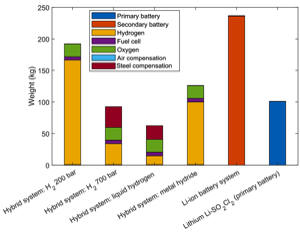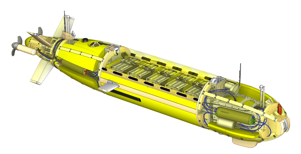AUV Technology
Annotated list with links to reports or papers.

Energy Storage
Recent concepts, developments and practical experience
A strategy for sizing and optimizing energy systems on long range AUVs
Long range under ice AUV missions in the Polar Regions have been a scientific requirement for over 30 years. Such missions include trans-basic transects under the sea ice of the Arctic Ocean and exploration of the seawater cavity beneath the extensive Filchner-Ronne Ice Shelf in Antarctica. While not directly addressing polar missions a paper by Chiche et al. (2021) focuses on sizing and optimizing a hybrid battery/fuel cell energy system for long range AUVs.
Drawing on actual power requirement profiles from a Hugin AUV, including from a 40-hour mission, they illustrate how to estimate a suitable power rating for a fuel cell stack, with typical battery charging and discharge times. They show that the fuel cell stack need not be designed to cope with peak power demand; in one example the optimum is about 50% of the peak, the battery being used to provide power during those peak periods.
Several practical points are raised in the extensive discussion including:
• Relevant to operation in Polar Regions they do highlight heat management, including the need for the fuel cell stack to be at an appropriate temperature before being started. If used intermittently, e.g. for rapid battery charging between long periods of being on standby, the performance metrics may be adversely affected by the need to consume reactants to stay at an appropriate temperature. The temperature of the environment may also affect reactant storage, e.g. maximum gas evolution rate from metal hydride hydrogen storage.
• The need for active buoyancy control with a fuel cell system, and how the resulting increase in mass and volume would affect the key performance metrics of specific energy and energy density.
• Handling produced water from the fuel cell is left as a matter for future study.
• Perhaps counterintuitively, they show that when missions become very long and energy intensive compressed oxygen at 153 bar or hydrogen peroxide (presumably at high concentration) can become weight and volume efficient.
• Strategies to minimise energy consumption underway are not addressed. They do refer to many studies into this topic for electric and hybrid cars and buses.
• Safety considered very briefly, and their study did not investigate or rank the hazards associated with pressure balanced and enclosed one-atmosphere systems.
Pressure-tolerant lithium polymer battery for an AUV specifically designed for under ice
The Autosub 2000 Under Ice (AUI2K) AUV is, as its name implies, specifically designed for operations in the Polar Regions. In a paper focusing on the adaptations required for under ice operation Phillips et al. (2020) outline the features of the vehicle's lithium ion energy storage system:
• Syntactic foam, rated to 2000 m, in the centre section encases pressure-tolerant lithium polymer battery packs.
• Four modules, each comprising 28 Kokam 12 Ah"pouch cells in a 2P14S configuration, form a 4.97 kWh battery, housed in oil-filled bespoke polyethylene boxes.
• Construction and certification to UN38.3 standards is being done by Steatite.
From Chiche et al. (2021), estimates of the weight (in air) of hybrid battery / hydrogen-oxygen fuel cell systems with different hydrogen storage options compared with secondary lithium ion and primary lithium sulfuryl chloride batteries.


From Phillips et al. (2020), concept design for the UK National Oceanography Centre AUI2K AUV specifically designed for operations in the Polar Regions. Note the lithium polymer battery modules in the centre section.